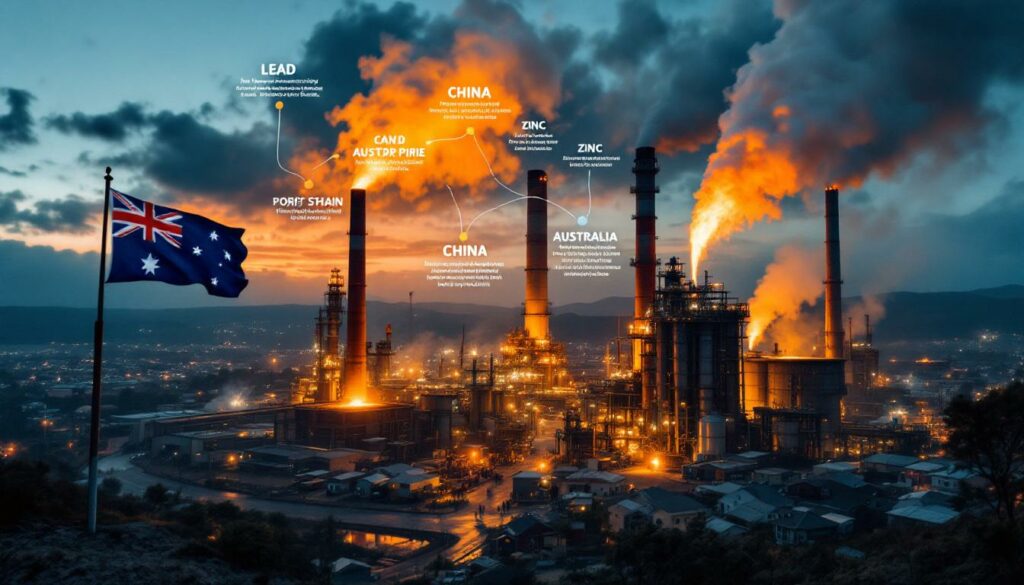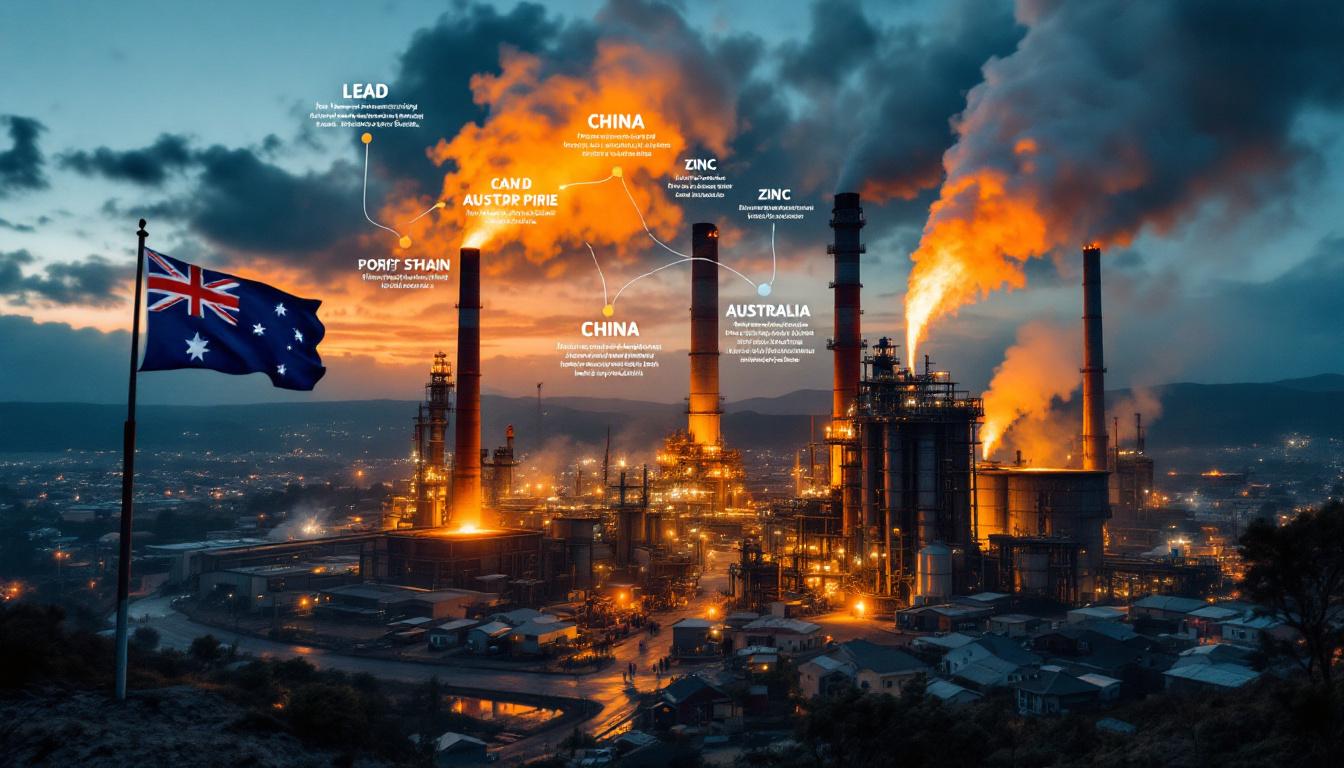Why Do Australian Smelters Need Government Support?
Australian smelting operations are facing an unprecedented financial crisis that threatens their very existence. The situation has become so dire that without immediate government intervention, these critical facilities may be forced to close within months, impacting thousands of jobs and undermining Australia's manufacturing sovereignty.
The Financial Crisis Facing Australian Smelting Operations
Nyrstar Australia, which employs over 1,400 workers across its Port Pirie and Hobart operations, is experiencing devastating financial losses that cannot be sustained without assistance. According to Matt Howell, Nyrstar Australia CEO, the situation has reached critical levels.
"The business at Port Pirie is losing very considerable money — tens of millions a month — because of this distorted market, and it requires a response now," Howell stated in June 2025, emphasizing that government assistance is needed within "weeks, not months."
The company has been transparent about the severity of the crisis, with Howell warning that "absent support, the business will simply not survive in the current market environment."
Key Financial Challenges
- Massive Monthly Losses: The Port Pirie lead smelter is hemorrhaging "tens of millions of dollars per month" according to company statements.
- Operational Interdependence: The Hobart zinc smelter cannot operate independently of Port Pirie, creating a domino effect across operations.
- Market Distortion: Chinese subsidies and market practices have created an uneven playing field that Australian smelters cannot compete in without assistance.
- Time Sensitivity: Without immediate intervention, these operations face imminent closure, with the company stating decisions are needed within "weeks, not months."
The crisis represents more than just a corporate financial problem—it's a national economic and strategic challenge that threatens Australia's industrial capability in critical metals processing.
How Did Chinese Market Practices Create This Crisis?
At the heart of the Australian smelting crisis lies what industry leaders describe as systematic market distortion created by Chinese government policies. These practices have fundamentally altered the economics of metal smelting globally, with particularly severe impacts on Australian operations.
Market Distortion Mechanisms
The distortion operates through a sophisticated three-part mechanism that effectively undercuts Australian smelters at every stage of the value chain:
- Subsidized Raw Material Acquisition: Chinese companies receive government subsidies that allow them to purchase Australian raw materials at prices that Australian smelters cannot match.
- Processing Subsidies: China then subsidizes the processing of these materials into finished metal products, further undercutting global market prices.
- Export Controls: Finally, China places export controls on finished metals, creating artificial market constraints and supply chain vulnerabilities.
Matt Howell explained the mechanism clearly: "China has distorted the metals market by subsidising companies to purchase Australian raw materials at prices Australian smelters cannot afford. China then subsidises the processing of those materials into metals while also placing export controls over the finished product."
This creates a perverse situation where Australian raw materials are shipped to China, processed with government subsidies, and then sold back to global markets (including Australia) at artificially low prices—or withheld entirely through export controls.
Impact on Australian Manufacturing
The effects of these market distortions extend well beyond Nyrstar's operations:
- Widespread Industry Impact: Port Pirie and Hobart smelters are the current focal point, but copper smelter shutdown operations face similar threats.
- Critical Supply Chain Vulnerability: Australia risks becoming dependent on Chinese processing for metals that are essential to modern manufacturing and defense industries.
- Loss of Industrial Capability: Once smelting operations close, the specialized knowledge, skills, and infrastructure are extremely difficult and costly to restore.
- Employment Cascade: Thousands of direct and indirect jobs are threatened, with regional communities bearing the brunt of these losses.
Tom Koutsantonis, South Australia's Energy and Mining Minister, emphasized the national scope of the crisis: "Smelters across the country are going through this because of the practices occurring in China, which is attempting to try and in-house this capability entirely in one country."
The situation highlights a broader strategic challenge for Australian manufacturing in countering market practices that systematically disadvantage domestic operations through government intervention in global markets.
What's at Stake for Regional Communities?
The potential closure of smelting operations in Port Pirie and Hobart would create profound economic and social impacts on communities that have built their identity around these industrial facilities for generations.
Employment and Economic Impact
The employment stakes are enormous for regional communities where alternative job opportunities are limited:
- Direct Employment: Port Pirie smelter directly employs approximately 850 full-time workers, while the Hobart smelter employs around 600 full-time workers.
- Contractor Positions: Hundreds of additional contractor positions depend on these operations, from maintenance specialists to logistics providers.
- Supply Chain Jobs: Local businesses supplying goods and services to the smelters would face severe contraction or closure.
- Multiplier Effect: Each direct smelter job supports multiple additional positions in the regional economy through the spending power of employees.
For Port Pirie in particular, the smelter has been the economic backbone of the community for over a century. Its closure would remove the city's largest employer and economic driver, with catastrophic effects on local businesses, property values, and community services.
Community Concerns
The uncertainty surrounding these operations has created significant anxiety and fear in affected communities:
- "Ghost Town" Fears: Port Pirie residents have expressed fear that without the smelter, their city risks becoming a "ghost town" as workers and families relocate to find employment.
- Business Uncertainty: Local businesses dependent on smelter operations and employee spending face uncertain futures, with many likely to close if the smelters shut down.
- Limited Diversification: Despite decades of efforts to diversify regional economies, many of these communities remain heavily dependent on these industrial facilities.
- Generational Impact: Multiple generations of families have worked at these facilities, creating not just economic but deep cultural and identity connections to smelting operations.
The social fabric of these communities is intrinsically tied to these industrial operations, with schools, sporting clubs, community organizations, and local government all facing severe challenges if the cornerstone employer disappears.
What Support Is Nyrstar Requesting?
Nyrstar Australia has framed its request for government assistance not as a corporate bailout but as a strategic partnership to preserve critical national capabilities while a sustainable path forward is developed.
Immediate Financial Assistance
The company is seeking "transitionary support" from federal and state governments to keep operations viable during a development phase:
- 22-Month Support Window: Financial assistance to offset losses during a 22-month feasibility study period for redeveloping the Port Pirie smelter.
- Significant Financial Package: While exact figures haven't been disclosed, the support is estimated to run into "hundreds of millions" of dollars based on current loss rates.
- Company Investment Commitment: Nyrstar has pledged to fund a $45 million feasibility study for Port Pirie smelter redevelopment, demonstrating skin in the game.
- Hobart Facility Upgrades: Additional investment needed for Hobart zinc smelter upgrades to ensure both facilities remain viable.
Matt Howell emphasized that this isn't simply a request for ongoing subsidies: "We're looking for a hand up, not a handout." The request is framed as temporary assistance during a transition period while longer-term solutions are developed.
Strategic Justification
Nyrstar has carefully positioned this request as an investment in strategic national capabilities rather than a corporate rescue:
- Sovereignty Argument: Preserving domestic smelting capability ensures Australia retains control over processing its own mineral resources.
- Critical Materials Security: Maintaining manufacturing capacity for materials essential to modern technology and defence critical materials strategy applications.
- Supply Chain Resilience: Reducing vulnerability to foreign export controls on finished metals critical to Australian industry.
- Skills Preservation: Protecting specialized industrial knowledge and capabilities that would be difficult to rebuild if lost.
"This is not subsidising something that is just an ongoing drain to the taxpayer," Howell stated. "This is about investing in strategically important businesses that provide the necessities to modern life and for our strategic defence purposes."
The company's approach aligns with growing national security concerns about critical minerals reserve processing capabilities and supply chain vulnerabilities exposed during recent global disruptions.
How Does This Compare to Other Industry Support?
The request for government assistance comes in a context where other struggling Australian industrial operations have received significant public support, raising questions about precedent and policy consistency.
The Whyalla Precedent
The most direct comparison is the recent support package for the Whyalla steelworks:
- $2.4 Billion Package: Federal and South Australian governments committed $2.4 billion to save the Whyalla steelworks in a landmark deal.
- Precedent Setting: Glencore has explicitly pointed to this precedent in seeking support for its Queensland copper assets facing similar challenges.
- Different Circumstances: South Australian Premier Peter Malinauskas has pushed back on direct comparisons, stating the Port Pirie smelter represents "completely different" circumstances to Whyalla.
- Scale Considerations: While the Whyalla package was $2.4 billion, Nyrstar's request is believed to be smaller but still in the "hundreds of millions."
The Whyalla precedent established that government intervention to preserve strategic manufacturing capabilities could be justified when market conditions threaten their viability, particularly when foreign market practices are seen as distorting normal competitive dynamics.
National Strategic Considerations
Government officials have acknowledged the broader strategic implications that transcend normal market considerations:
- National Security Framework: SA Energy and Mining Minister Tom Koutsantonis described the situation as an "Australia smelter issue" requiring a "national response."
- Coordinated Response: Ongoing discussions between state and federal governments indicate recognition that the issue exceeds the capacity of any single jurisdiction.
- Critical Minerals Strategy: The situation connects to Australia's broader critical minerals strategy and concerns about sovereign manufacturing capabilities.
- Defense Industry Linkages: Metal processing capabilities have direct implications for defense industry supply chains and strategic self-sufficiency.
The framing of smelting operations as strategic national assets rather than simply commercial ventures represents a significant shift in how these facilities are viewed from a policy perspective. This mirrors international trends where critical mineral processing is increasingly seen through a national security lens.
What Solutions Are Being Explored?
The response to the smelting crisis involves both immediate stabilization measures and longer-term transformation strategies to ensure sustainable operations in a challenging global market.
Short-Term Stabilization
The immediate focus is on keeping facilities operational while longer-term solutions are developed:
- Financial Bridging: Government discussions with Nyrstar have focused on providing financial support to offset market distortion effects during a transition period.
- Trade Policy Responses: Exploration of potential trade policy interventions to address Chinese market practices that disadvantage Australian operations.
- Strategic Designation: Consideration of designating metal smelting as essential national infrastructure to justify intervention beyond normal market principles.
- Multi-jurisdictional Approach: Coordination between federal and state governments to develop a comprehensive response package.
Tom Koutsantonis indicated the federal Industry Minister Tim Ayres is "actively looking at this on behalf of the entire country," suggesting the seriousness with which the federal government views the situation.
Long-Term Transformation
Beyond immediate financial support, multiple strategies are being considered to transform these operations for long-term viability:
- Technological Redevelopment: Nyrstar's proposed $45 million feasibility study for Port Pirie smelter redevelopment aims to identify technological upgrades that could improve efficiency and competitiveness.
- Product Diversification: Exploration of new product lines and higher-value outputs that could command premium prices in global markets.
- Energy Transition: Investigation of renewable energy options to reduce operating costs and improve environmental performance.
- Public-Private Partnership Models: Consideration of innovative ownership structures that might better balance commercial and strategic imperatives.
Matt Howell has expressed confidence that solutions will be found, noting that government officials "recognise the seriousness, they recognise the urgency" of the situation.
The 22-month feasibility study represents a concrete step toward reimagining these operations for a changed global market, but requires bridging support to reach that point without facility closures.
What Are the Broader Implications for Australian Manufacturing?
The crisis in Australia's smelting industry raises fundamental questions about the future of manufacturing in a global economy where market distortions and strategic considerations increasingly complicate purely commercial decision-making.
National Sovereignty Concerns
The situation highlights growing anxieties about manufacturing sovereignty and strategic vulnerability:
- Raw Material Paradox: Australia exports vast quantities of raw materials only to become dependent on overseas processing of those same materials.
- Strategic Vulnerability: Reliance on foreign processing creates potential points of leverage that could be exploited during international tensions.
- Knowledge Erosion: The loss of specialized industrial capabilities and knowledge represents a form of national deskilling that is difficult to reverse.
- Critical Supply Chains: Modern manufacturing, renewable energy, and defense industries all depend on reliable access to processed metals.
As Tom Koutsantonis observed, China is "attempting to try and in-house this capability entirely in one country," creating a strategic concentration of processing capacity that raises concerns beyond normal market competition.
Policy Challenges
The situation presents complex and sometimes contradictory policy challenges:
- Free Market Principles: Interventions to support private industrial operations must be balanced against market-based allocation of resources.
- International Trade Rules: Addressing market distortions through policy interventions requires navigating complex WTO and bilateral trade agreement frameworks.
- Taxpayer Value: Determining appropriate levels of public investment requires clear articulation of the strategic value of these operations beyond commercial metrics.
- Climate Transition: Supporting traditional heavy industry must be reconciled with decarbonization goals and environmental considerations.
These challenges require a sophisticated policy response that transcends traditional economic frameworks to incorporate strategic, social, and environmental considerations alongside commercial viability assessments.
The path forward will likely require new models of public-private cooperation that recognize both the commercial realities facing these operations and their strategic importance to national capabilities and regional communities. Furthermore, understanding mineral beneficiation insights from other countries could provide valuable guidance for Australia's approach.
What Happens Next?
The smelting crisis is rapidly approaching a decision point, with key developments expected in the coming weeks that will determine the fate of these operations and the communities that depend on them.
Critical Timeline
Several key milestones will shape the path forward:
- Urgent Decision Window: Nyrstar has indicated decisions are needed within "weeks, not months," suggesting a critical deadline in July 2025.
- Government Deliberations: Ongoing discussions between company officials, state governments, and federal representatives are intensifying as the timeline compresses.
- Support Package Announcement: A formal announcement on government support is expected before the end of July 2025 based on the company's timeline.
- Feasibility Study Launch: If support is secured, the 22-month feasibility study for Port Pirie redevelopment would likely commence by August 2025.
The compressed timeline reflects the severity of financial losses being experienced by the operations, with Matt Howell emphasizing that current conditions are simply not sustainable without intervention.
Stakeholder Positions
Various parties have staked out positions on the path forward:
- Nyrstar Australia: CEO Matt Howell has expressed confidence in finding a solution, noting that government officials recognize both the "seriousness" and "urgency" of the situation.
- South Australian Government: Has positioned this as a national issue requiring federal leadership while indicating willingness to participate in a solution.
- Federal Government: Industry Minister Tim Ayres is "actively looking at this on behalf of the entire country" according to state officials.
- Regional Communities: Local leaders and community members are advocating strongly for preservation of these operations, emphasizing their economic and social importance.
The overlapping interests of these stakeholders suggest the potential for a coordinated response, though significant questions remain about the scale, structure, and conditions of any support package.
As Matt Howell stated: "They recognise the seriousness, they recognise the urgency, and we're confident we'll get a solution." The coming weeks will determine whether that confidence is justified and what form any solution might take as the industry confronts evolving mining industry trends that will shape its future.
FAQs About Australian Smelter Crisis
Why can't Australian smelters compete in the current market?
Australian smelters face significant challenges competing in the global market due to what industry leaders describe as market distortion practices from China. These include subsidized purchasing of raw materials, subsidized processing, and export controls on finished products. According to Nyrstar Australia CEO Matt Howell, these practices create an uneven playing field where "China has distorted the metals market by subsidising companies to purchase Australian raw materials at prices Australian smelters cannot afford."
Additionally, Australian operations face higher energy costs and stricter environmental regulations compared to some international competitors. These combined factors have created a situation where domestic smelting operations cannot remain financially viable without temporary government support.
How many jobs are at risk if these smelters close?
Approximately 1,450 direct full-time jobs are at risk across the Port Pirie and Hobart smelters, with Port Pirie employing around 850 workers and Hobart about 600
Want to Capitalise on the Next Major Mineral Discovery?
Stay ahead of the market with Discovery Alert's proprietary Discovery IQ model, which delivers instant notifications when significant ASX mineral discoveries are announced. Visit our discoveries page to understand how major mineral discoveries have historically generated substantial returns for early investors.




